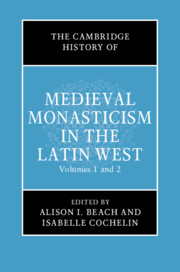Book contents
- The Cambridge History of Medieval Monasticism in the Latin WEST
- The New Cambridge History of Medieval Monasticism in the Latin West
- The Cambridge History of Medieval Monasticism in the Latin WEST
- Copyright page
- Contents
- Figures
- Contributors
- Acknowledgments
- Abbreviations
- 1 General Introduction
- Part I The Origins of Christian Monasticism to the Eighth Century
- Part II The Carolingians to the Eleventh Century
- Part III The Long Twelfth Century
- 34 Historiographical Approaches to Monasticism in the Long Twelfth Century
- 35 Sources for Monasticism in the Long Twelfth Century
- 36 Hermitism in the Eleventh and Twelfth Centuries
- 37 Monastic Theologies, c. 1050–1200
- 38 Monastic Preaching and the Sermon in Medieval Latin Christendom to the Twelfth Century
- 39 The Mass in Monastic Practice: Nuns and Ordained Monks, c. 400–1200
- 40 Reclusion in the Middle Ages
- 41 Similarities and Differences between Monks and Regular Canons in the Twelfth Century
- 42 The Institutionalization of Religious Orders (Twelfth and Thirteenth Centuries)
- 43 Gender and Monastic Liturgy in the Latin West (High and Late Middle Ages)
- 44 Monastic Landscapes
- 45 Later Monastic Economies
- 46 Nobility and Monastic Patronage: The View from Outside the Monastery
- 47 The Medical Role of Monasteries in the Latin West, c. 1050–1300
- 48 East-Central European Monasticism: Between East and West?
- 49 Monasticism, Colonization, and Ethnic Tension in Late Medieval Ireland
- Part IV Forms of Monasticism in the Late Middle Ages
- Index
- References
35 - Sources for Monasticism in the Long Twelfth Century
from Part III - The Long Twelfth Century
Published online by Cambridge University Press: 16 January 2020
- The Cambridge History of Medieval Monasticism in the Latin WEST
- The New Cambridge History of Medieval Monasticism in the Latin West
- The Cambridge History of Medieval Monasticism in the Latin WEST
- Copyright page
- Contents
- Figures
- Contributors
- Acknowledgments
- Abbreviations
- 1 General Introduction
- Part I The Origins of Christian Monasticism to the Eighth Century
- Part II The Carolingians to the Eleventh Century
- Part III The Long Twelfth Century
- 34 Historiographical Approaches to Monasticism in the Long Twelfth Century
- 35 Sources for Monasticism in the Long Twelfth Century
- 36 Hermitism in the Eleventh and Twelfth Centuries
- 37 Monastic Theologies, c. 1050–1200
- 38 Monastic Preaching and the Sermon in Medieval Latin Christendom to the Twelfth Century
- 39 The Mass in Monastic Practice: Nuns and Ordained Monks, c. 400–1200
- 40 Reclusion in the Middle Ages
- 41 Similarities and Differences between Monks and Regular Canons in the Twelfth Century
- 42 The Institutionalization of Religious Orders (Twelfth and Thirteenth Centuries)
- 43 Gender and Monastic Liturgy in the Latin West (High and Late Middle Ages)
- 44 Monastic Landscapes
- 45 Later Monastic Economies
- 46 Nobility and Monastic Patronage: The View from Outside the Monastery
- 47 The Medical Role of Monasteries in the Latin West, c. 1050–1300
- 48 East-Central European Monasticism: Between East and West?
- 49 Monasticism, Colonization, and Ethnic Tension in Late Medieval Ireland
- Part IV Forms of Monasticism in the Late Middle Ages
- Index
- References
Summary
The long twelfth century (c. 1050–1215) has been characterized by medievalists as a period of “renaissance” and “renewal”; a time of the “crisis” of cenobitism and the “new” monasticism; the “discovery” of the individual; and the “Gregorian” reform. These appellations are stories told in the historiography, and are therefore susceptible to trends, schools of thought, and scholarly debate. But how did medieval monks and nuns characterize this period for themselves? What is unquestioned about the long twelfth century is that there is an increase in the type and availability of source material for historians of monasticism. Buildings still stand. Texts endure in multiple copies. Manuscripts survive more readily and in more legible hands. Translations and editions of sources abound.
- Type
- Chapter
- Information
- The Cambridge History of Medieval Monasticism in the Latin West , pp. 667 - 683Publisher: Cambridge University PressPrint publication year: 2020



